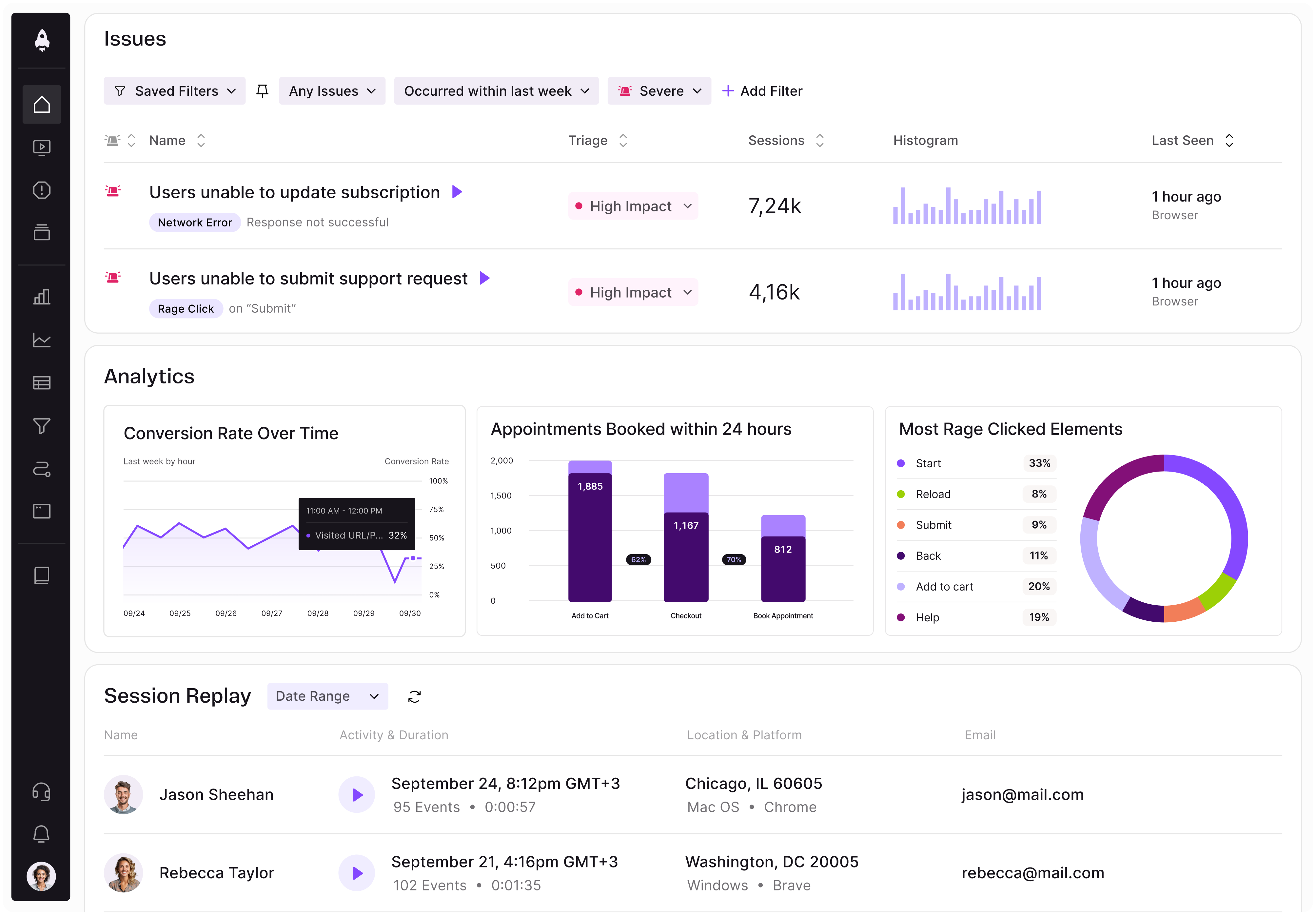Rachel Bentley is Vice President of Product Management, Seller Experience at G2. She began her career in retail at JCPenney, where she developed a deep appreciation for customer needs and merchandising strategy. That frontline retail experience sparked a passion for creating seamless shopping experiences, which she carried into the digital space.

She then transitioned into ecommerce with roles that allowed her to blend business insight with user empathy. At Sears, Rachel shaped the strategy behind an expansive catalog of product display pages, optimizing the experience to boost discoverability and drive meaningful conversion at scale. She later served as a product leader at PowerReviews, where she helped brands harness the power of user-generated content to build trust and drive sales.
At G2, Rachel now leads the Seller Experience product team, shaping tools and insights that empower B2B technology vendors to grow through authentic customer voice and data-driven decision-making.
In our conversation, Rachel discusses the importance of companies remaining transparent about their reviews and where they’re sourced from to foster user trust. She also talks about the implications of users unintentionally misusing a product and how AI is changing the ratings and review landscape for users and businesses.
Transparency and clarity are key. As a user, regardless of your industry, you don’t want to purchase something with the intention that it won’t work. From a software perspective, you don’t want to go through the procurement process again. You want it to work because you have a business need to meet your goals. And if it’s a physical product, you don’t want to wait in line at USPS or FedEx to return the product and ship it back to the company.
In terms of the primary purchase inputs for a user, such as size, fit, dimensions, or software integrations, effective communication is key for supporting purchase decisions and gaining trust. Also, I see clutter on so many user experiences, especially near the buy-backs. It feels like you’re looking at Times Square — there’s so much clutter. You don’t really know where to look, so companies need to be intentional about design so they can build trust and communicate clearly. When a company is not communicating clearly, trust breaks down. That’s why a clean user experience with primary purchase information, which varies by industry, is imperative.
Finally, I’d be remiss if I didn’t talk about reviews. Communicate where reviews came from and how they were sourced. Coming from a B2C background, I personally look at the code when shopping online to see where a company pulls reviews from, because certain vendors allow cherry-picking for positive-only reviews. If a product, regardless of industry, has not a single one-star review, that’s not real life — not every product works perfectly for every single person.
That’s kind of human nature. You look at the weather report in the morning to think, “What could be the worst-case scenario?” Or you look at the traffic ahead of time to understand how long it’s going to take you to get somewhere because you want to manage your expectations. If you look at the one-star reviews, you want to know what the worst thing that could happen is, or if that applies to you.
The procurement process is painful, especially with software. You have to go through legal, security, finance, and more. You don’t want to have to do that again, and it takes so much time. So, what is the best-case scenario? What is the worst-case scenario? Finding your way to set yourself up for success in the best-case scenario is key to making the right purchase decisions.
Using data is the number one thing I do. Where does a user find friction? Empathy has to come from a lot of places — it can’t just be click data and A/B testing. Don’t get me wrong, I LOVE click data and A/B testing, but user interviews are key to ensuring you have the right balance of quantitative and qualitative information and truly understand your user. Modern analytics and AI are never going to replace human connection. You need the human element to understand your user and their anger.
I’ve had moments from my work in both B2C and B2B where a user’s expectations of G2 were mismanaged. They were very upset, and that’s how they came to talk to me, and I knew I had to do better. Click data is not going to tell me that. I’ve been at G2 for five years, and that occurred in my first year. I think about that woman who yelled at me at least once a month because she was 100 percent right — we mismanaged her expectations. No amount of A/B testing is ever going to give me that moment.
It goes back to values and integrity. I always go back to that and a mission statement. At G2, our mission is to be where you go for software. We are not required to be ADA compliant, but none of our competitors have ADA compliance on their sites. Since it’s a commitment of G2 to be where you go for software, we know we should be ADA compliant even if there isn’t an ROI to our goals, because if we want everyone to use our platform, we need to consider all abilities. That’s our mission as a company.
Sellers get upset about negative reviews or their placement on the grid. A lot of times, they’ll come to us and say, “This is my goal for the product. I want buyer intent signals.” But if they haven’t collected a review in a year, they’re not going to get buyer intent signals because to get buyer intent signals, you need an engaged end user.
The number one way to drive engagement and traffic is to get new reviews. It’s like if you’re on Amazon — are you going to buy something that the last review was a year or two ago? You’re not going to get that. You end up at the top of the list from having fresh content. That’s something we emphasize to users so their expectations are aligned with our platform.
This happens all the time. People are always going to misuse products. For example, Q-tips are not supposed to go in your ears, but that’s what everyone uses them for.
You have to decide what your goal is. If users are misusing your product, but it’s working for them and it’s not against your trust or your rules, my mantra is to have at it. Go ahead! But if they’re abusing your product in a way that unintentionally hurts themselves or others, that needs to be addressed. I’ve encountered this many times in my career, sometimes unintentionally, but it’s best to assume positive intent and move on.
When I ask G2 customers their goal, they almost always say buyer intent. They’re not prioritizing that review collection, but the number one way to get traffic to your page and buyer intent signals is through reviews. Sometimes, people aim for the top of the mountain and accidentally go downhill. That’s when you have to remind them about the best path forward for using your product.
A lot of the feedback we get is, “Your reviews are biased.” Well, it’s somebody’s experience. I’ll use a restaurant example. Have you ever had a friend tell you to go to a restaurant, and they’re like, “This place is the best.” And then you get there and you’re like, “Is it?” The service is lacking, or the food doesn’t meet your expectations. People have different experiences using the same products or services all the time.
It’s not that the reviews are not trusted due to AI. Adjusting someone’s story to represent what happened while removing judgment helps both parties.
Reviews and product feedback are second only to word of mouth, but with reviews, people judge one another, from grammar to word choice and spelling. Taking that story and changing it to remove some of that judgment is one way that AI helps. Further, it can summarize the feedback into a succinct statement for an overview to expedite someone’s understanding of how others found the product. The question, “Is this going to work for me?” can be answered instantly.
With that, I’ve noticed that people hesitate to believe some reviews are real. At G2, we have our own products listed on our site. I read and reply to every single review. Not all require a response, so showing credibility has become important. We’re transparent about how we moderate, that someone has used a product, and about the source of the reviews or the summary.
It’s interesting. I’ve been doing this for 16 years, with the last 8.5 specifically in the ratings and reviews space. The number one action people take is always to filter by the lowest star rating review. That’s the first thing that they do on every product page. Before advancements in AI, that was still true, and that hasn’t changed. Now, they’re reading the summary first, but then they still want to read the dirt.
Not every product is going to work for every person. Even with AI and the summaries it provides, you still need to have flexibility. You still need to give users options to know who said what and dig into the reviews to see if the product is right for them. That functionality and interaction help one user understand another user and are key to community connection and purchasing.
As I said, AI is never going to replace human connection. Many of our reviews are confirmed to come from a specific person. Over 50 percent of our reviews on G2 are signed in via LinkedIn. That’s a real person. Knowing that that person exists and is doing a job similar to yours, your trust hasn’t eroded.
With AI, you’re seeing all these B2B companies pop up. We’re probably catching up a little bit faster. Even a few years ago, when you ordered something online, it would be shipped to you in 10 days, which was exciting. Now, it’s like, “It should be here by the end of this sentence.” I’m seeing with the advancements in AI that we might be able to close that gap a little bit.
For example, we are introducing voice reviews on G2. You can chat back and forth to fill out the review form, which exponentially improves the time to submit reviews. I only use talk-to-text because I’m a busy mom. Sometimes it doesn’t understand me, and I don’t even care. I’m like, “My friends will figure out what I meant.” Advancements are occurring that are closing that gap, and though user expectations are going to be set in B2C, we’re closing that gap.
An analogy that my co-worker, Tim Sanders, says is, “AI is like butter. It improves everything, but it doesn’t have a use case by itself.” People still need to be involved in AI. You can co-pair with an AI agent to code faster, but the human and empathy element will never be there. You don’t miss a robot. You don’t have emotions with a robot, and it doesn’t have those emotions. I see product management shifting to more of those soft skills versus execution.

LogRocket identifies friction points in the user experience so you can make informed decisions about product and design changes that must happen to hit your goals.
With LogRocket, you can understand the scope of the issues affecting your product and prioritize the changes that need to be made. LogRocket simplifies workflows by allowing Engineering, Product, UX, and Design teams to work from the same data as you, eliminating any confusion about what needs to be done.
Get your teams on the same page — try LogRocket today.

Promotions depend on proof. This guide shows PMs how to capture wins, feedback, and impact before review season.

Most teams fail at autonomy. Learn how clear rules help product teams move faster without micromanagement.

A practical framework for PMs to use AI in ideation without sacrificing judgment, strategy, or decision quality.

A practical five minute revenue estimation method to help product managers compare ideas, drop low impact features, and prioritize smarter.